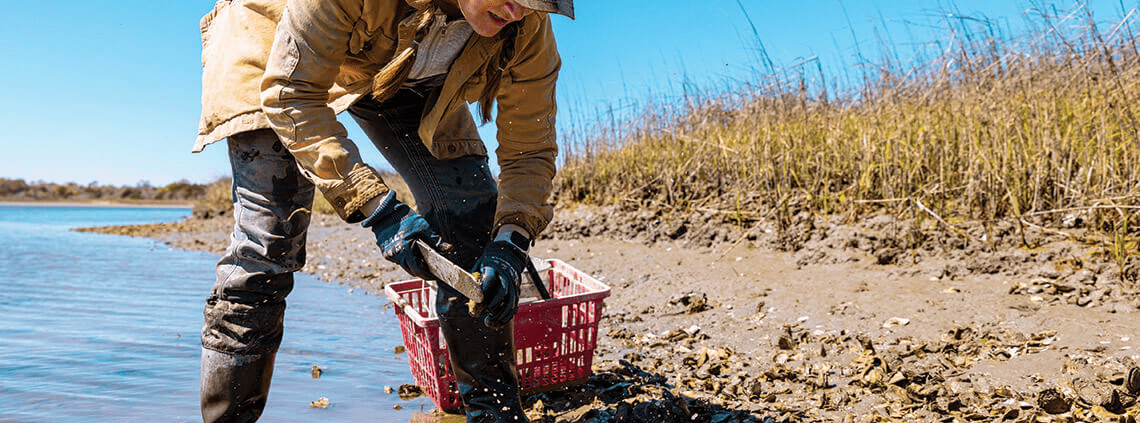The Shellfish Queen of Wrightsville Beach
by John Jeremiah Sullivan on May 29, 2023 | Reprinted from Our State
During a day in the marsh with a professional oysterwoman, a Wilmington writer who was born and raised in the Midwest learns to stop worrying and love the briny flavor of fresh, wild oysters.
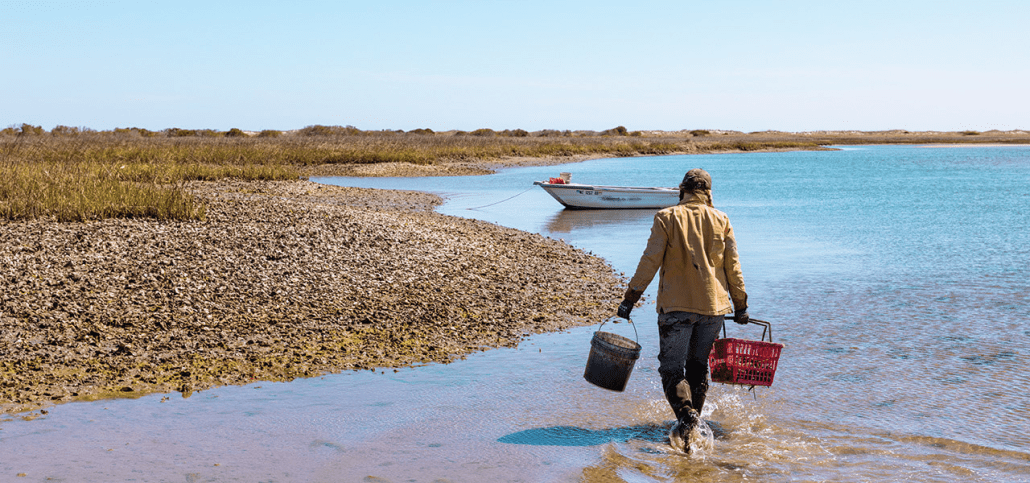
Earlier this year, I was having raw oysters at Manna in downtown Wilmington and chatting with the bartender, an affable, bearded guy in his mid-40s. We were talking about seafood, and it was evident that he knew a fair amount. “You seem to be really into fishing,” I said at one point. He reached down, undid the cuffs of his shirtsleeves, and rolled them up. His arms were covered in realistic blue-green tattoos of various finfishes and shellfishes and tackle. “You could say so,” he said.
The oysters that night seemed especially good, and the bartender explained why: They were wild as opposed to “farmed,” or cultivated. They’d been harvested on Masonboro Island, off the coast of the Cape Fear peninsula, not even 10 miles to the southeast of where we sat. On the menu, they were listed as “Masonboro Wild Selects.”
To understand the pleasure that I take in eating oysters in my adopted hometown of Wilmington, you’d need to come from a place like I do, on the borderlands of Indiana and Kentucky, where the nearest coast lay along the Patoka Lake reservoir. You didn’t want to mess with oysters so far into the interior. Too risky. Only when I moved to North Carolina 20 years ago did I come to appreciate how special raw oysters are and how different they can be from one another. The oysters we eat here are so fresh that you can taste the seawater from the deck of the boat they came in on.
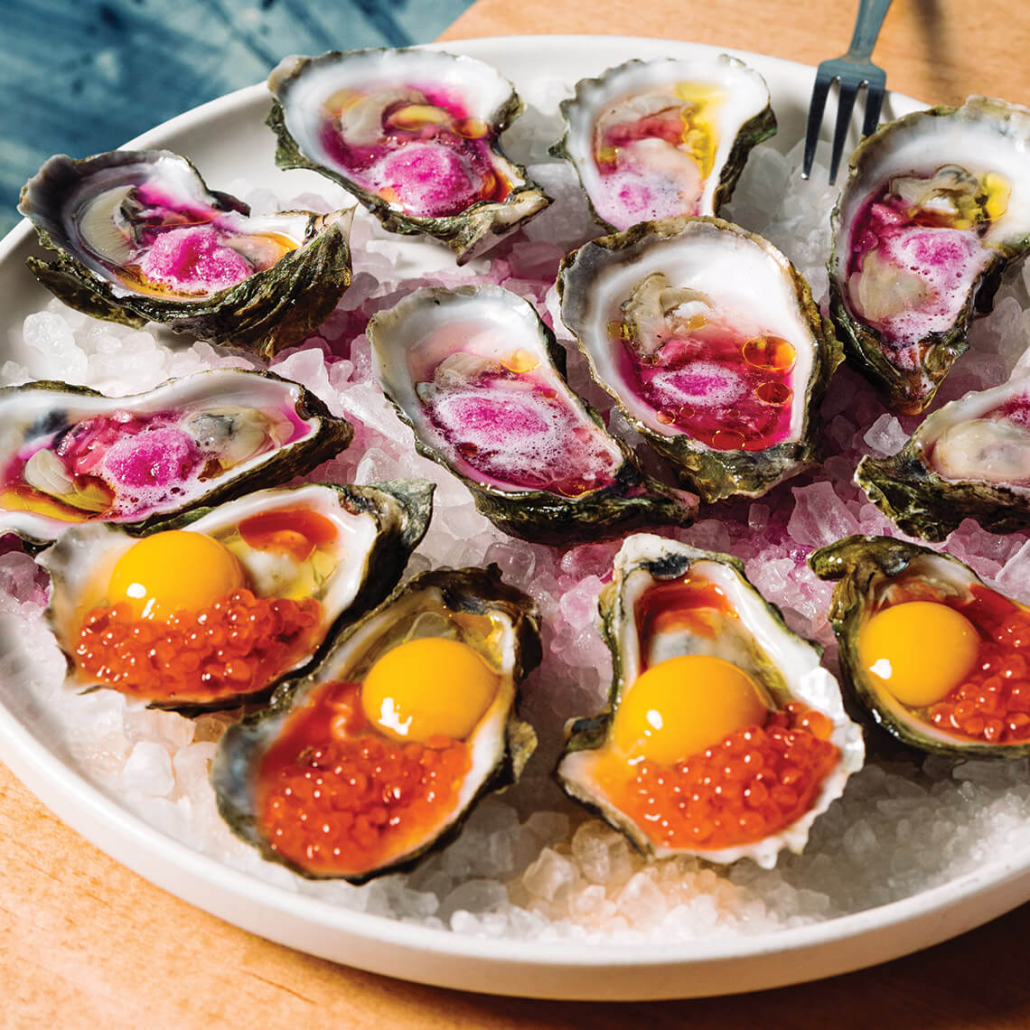
I had always assumed that half of the raw oysters found in local restaurants were wild, but it turns out that only a small percentage are. Nationally, the figure is tiny, like 5 percent. That has a lot to do with the obliteration of their habitat. In a place like Wilmington, situated in a fertile spot on the coast, the number might flutter upward during peak season, but not by much. That makes sense. Most restaurants value consistency above almost anything, and an oyster farmer can turn out a satisfying and essentially identical product week after week. But wild oysters possess more interest, flavor-wise. While the cultivated ones are often grown on a type of scaffolding, or “growing rack,” in watery environments where conditions are relatively fixed, wild oysters bear in their bodies the full vicissitudes of the sea: the rolling and tumbling, the greater variety of minerals that filter through from the marshes.
My bartender said that he likes to harvest wild oysters himself, prospecting for them in a skiff. He locates the beds at the edges of marshes and along the barrier islands. “My biggest trick for finding them,” he told me, “is to catch them spitting.” I asked what he meant. “When you see the tide go out and the water go down, and they start to become uncovered,” he explained, “you’ll see them literally start spitting, like somebody spitting into a spittoon.” He paused. “If you really want to know about oysters,” he said, “you need to talk to Äna Shellem.” He described her as someone whose mission is to raise awareness about wild oysters and other shellfish.
“Is that her real name?” I asked. “Shellem?”
“That’s her real name.”
“That’s my real name,” Äna Shellem says, by way of hello, when she picks up the phone. She likes to get that out of the way early on. Her maiden name is Gilmore. She’s in her 30s, tall, with a round, friendly face and blonde braids. She was born in Tennessee, became a child actor and stage performer, then lived for a while in New York City, where she did some time in the fine-dining world. In 2012, she met a man named Jon Shellem, who co-owns a bar down here, Red Dogs in Wrightsville Beach. Jon was living on a sailboat at the time and doing lots of shellfish harvesting. With him, Äna experienced for the first time what she calls “the feeling the marsh gives me.”
She married Jon, got her fishing and dealer’s licenses, and started selling wild shellfish directly to local restaurants. These days, she’s one of eastern North Carolina’s main boutique shellfish suppliers. In what surely ranks among the least difficult decisions in the history of company-naming, she chose to call her business Shell’em Seafood.
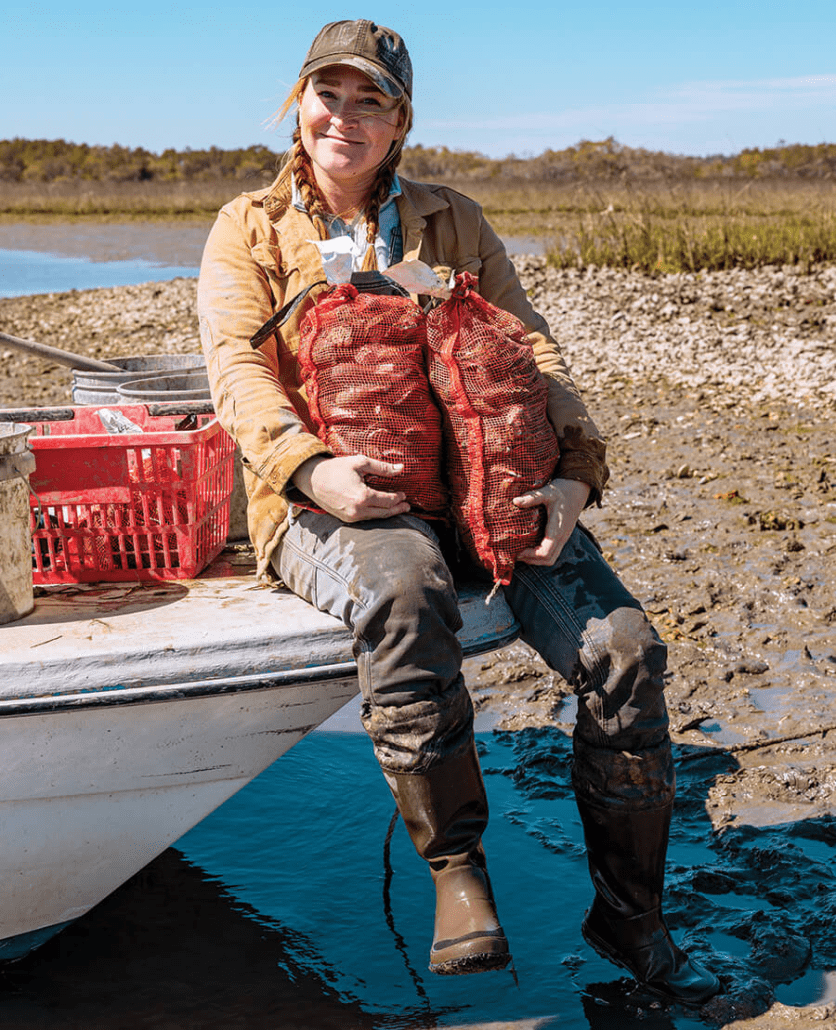
One morning a few weeks later, I find myself riding with Shellem in a small boat out from the marina at Wrightsville Beach. It’s late March, the moon is new, and the wind is blowing from the northeast. The water level is high in the marshes. We cruise along smoothly on turquoise water under a cloudless sky, out toward Masonboro Island. “We don’t have a great tide today,” Shellem says.
When you live in downtown Wilmington, as I do — 30 miles up the Cape Fear River from where it empties into the sea — it’s possible to forget how close you are to the undeveloped barrier islands that line the coast. As Shellem steers, we pass the last few clusters of big waterfront houses and enter the wild. Pelicans fly parallel to our path as if wanting to know where we’re headed. I am transported in a way that seems disproportionate to the nearness of these untouched beaches. A short drive, a quick boat ride, and it’s another world.
Shellem pays daily attention to the moon and the wind and the tide. They tend to determine the amount of time that she can work in a particular area. If there’s a wind from the northeast, as there is today, she might have only 45 minutes to wade a hundred yards to the center of a marsh, where she knows the shellfish are, and return safely to the boat. “The childhood fear of quicksand comes back quick,” she says, “when you’re alone and sink into the marsh up to your ribs.”
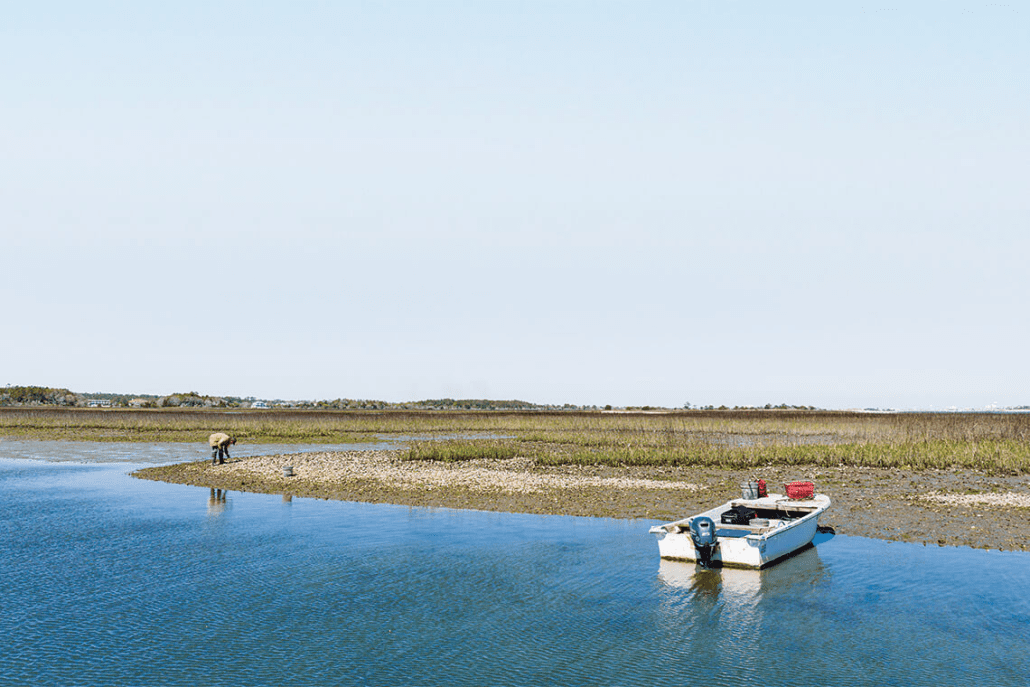
After about 20 minutes, she slows the boat, and we putter up to a little spit of muddy sand at the edge of a marsh. The beach is covered in gray oyster shells. Most are dead — that is to say, empty — but a certain number still have the living animal inside. I can hardly tell the difference between the two, but Shellem’s eye instantly singles out the live ones. And that’s how she refers to them: as singles.
As we crunch around in our boots, Shellem explains how the oyster bed formed. At first, you have feathers, young oysters with relatively straight, thin shells that “grow out in a very ugly, blooming-onion kind of way,” she says. As the clusters are tossed by storms, or the wake of boats, or the shuffling of sandbars, the oysters shift enough that some shells break off and tumble to the bottom of the pile. “That’s where I find the nuggets that I like,” Shellem says, “the ones that are thick enough.”
Some restaurants serve the younger feathers. “You can sell them to fish shops for use in stews that feed a bunch of people quickly,” she says. But Shellem deals mainly with restaurants that serve raw oysters, so she hunts for the singles. It’s not just their thickness that’s attractive to her, but also the shape. As the oysters grow and are tossed around in the ocean, their shells become twisted by the changes in position. They develop deeper cups, where a juicier mollusk can develop. “It’s not going to be stringy or anything,” she says. “It’ll be more velvety, more of a full-mouth feel.” Another thing: The meat-to-shell proportion is better. “Most chefs will tell you that you eat with your eyes first,” Shellem says. She keeps her eyes out for shells with what she calls “that beautiful mermaid tail,” knowing that when they’re opened, they’ll likely display a “purple pearly sheen.”
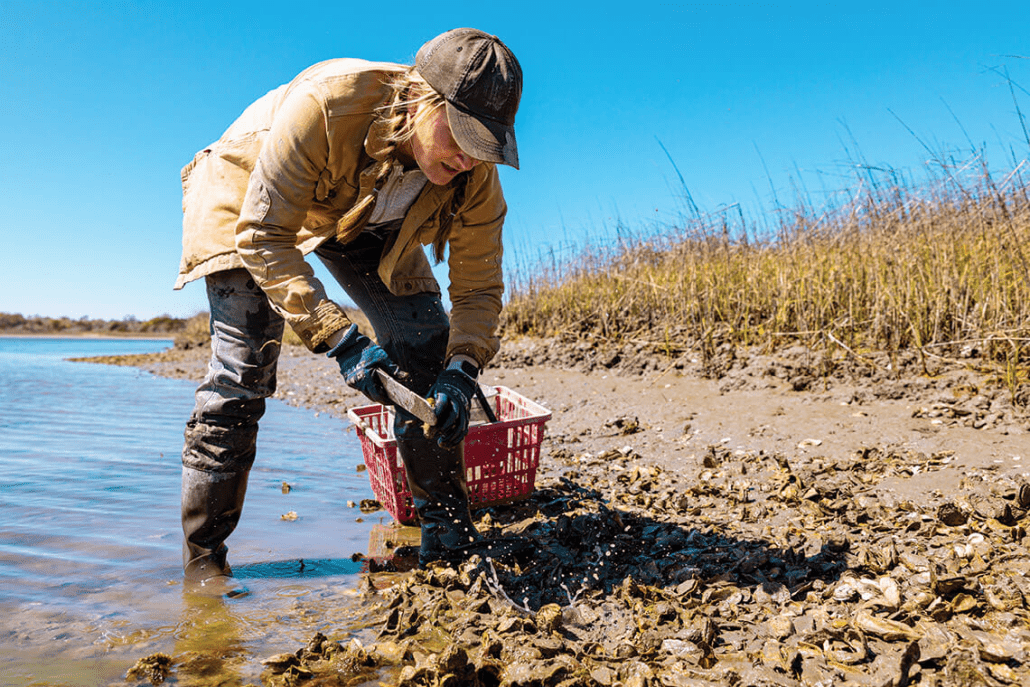
Shellem moves through the marshes with a culling tool, a sort of small machete that she’s customized by putting notches at every three inches along the back end. The law stipulates that wild oysters can be harvested only after they’ve reached a length of three inches, so with her homemade knife, Shellem is able to measure as she goes. “I call it my cluster buster,” she says.
I pick up an oyster that looks roughly like the ones she’s gathering. “Is this one?” I ask, like a kid with a rock that he hopes is an arrowhead.
“Good job!” she says. “And you cut your hand, too, like a real marsh boy.”
I look down and see that one of my fingers is bleeding. I hadn’t realized how sharp the shells were when I reached for it.
“Do you want to eat this one?” she asks.
“You mean, like, right here?”
“Yeah!” she says.
“Um, sure. Is that … how you do it?”
She pulls out a pocketknife, inserts the blade at the base, and then works it along the edge, prying the two halves apart until the shell pops open. I hesitate before tipping the oyster back into my mouth. Shellem watches closely.
“Oh my God,” I exclaim. “That was so good!” It’s salty and — to borrow her word — velvety, full of what can only be described as oyster flavor (the Japanese have an untranslatable term for it). I’m surprised at how surprised I am to like it. I confess to Shellem that I’d always figured restaurants were doing something to the oysters to make them more palatable. I don’t know what I thought that something was. The mignonette? The ice?
“That’s the beauty,” she says. “They come out of the ocean tasting like that.”
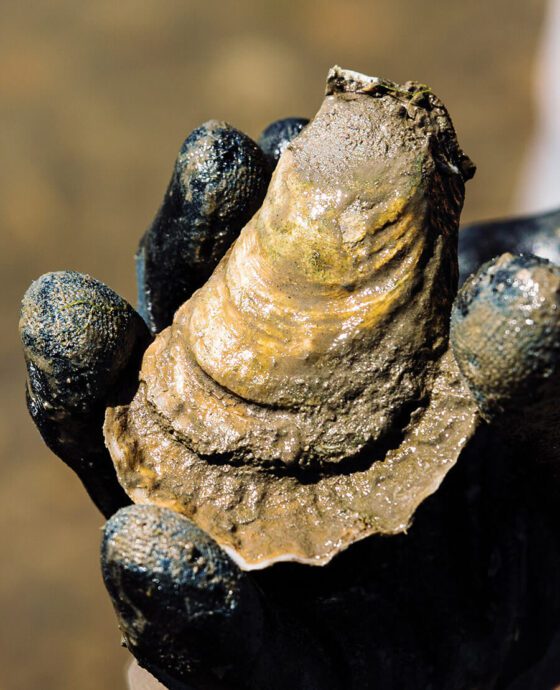
As the boat moves away from the marsh and back toward Wrightsville Beach, I ask Shellem to define that “feeling of the marsh” — the sensation she’d spoken of when we first talked by phone, the feeling that changed her life and turned her into a professional oysterwoman. Part of it, she says, is “the sheer empowerment and confidence of driving a boat on your own.” On top of that, Shellem says, she loves having “a job that I know will end with a work of art on some chef’s plate.” But most important: “The feeling the marsh gives me is that I can always feed my family. I can always feed my friends.”
I know what she means, if only in a vicarious way. So much of the food that we eat has, at best, an abstract provenance, words on a label. These oysters have come straight from the sea, 10 miles from my house. As I just learned on the beach, slurping down the freshest oyster that one could find, they hardly need touching before they’re edible and delicious.
Shellem gives me a bag to take home, and I serve the oysters that night. The kids seem impressed — they’ve never seen me bring home food that wasn’t from the grocery store. The effect, for me, is one of existing more intensely in the place where I live. Tasting and becoming one with it. The experience of ordering raw oysters at Manna will never be the same. It will be better — and, like the shell-cups of the singles that Äna Shellem harvests in the marshes, deeper.

